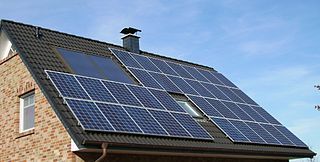From Guest Blogger Max Cohen: Selling Power Back to the National Grid
More and more people across the UK are becoming eco-conscious and deciding to turn their house into a bastion of renewable energy – and they are reaping the rewards for it. With energy prices only seeming to get more expensive, read on to find out how you can escape the rise and fall of oil and gas prices and start making money from green energy.
Getting your house in order
Before you can start making money, you’ll need to fit you house out with green energy generating technology. Currently in the UK there are three main ways to produce your own renewable energy:
Solar
If you live in an applicable area then you can harness the power of the sun to start making your own energy. Solar photovoltaic (PV) panels cost anything between £5,000 and £10,000 and, contrary to popular belief, do still produce energy on cloudy days. The panels work by electric fields being created when light shines through the PV cell’s semi-conducting silicon material.
Wind
Currently 40% of Europe’s wind energy blows across Britain, making it an ideal force to harness from your home. Turbines vary in price depending on how much energy you are looking to generate, but can range from £2,000 to over £20,000. The stronger the wind in the area, the more energy you will produce and be able to sell, with most turbines only costing around a hundred pounds a year in maintenance.
Hydro
It goes without saying that this type of energy generation is only applicable to those who live next to a suitable water source. But if your river or stream has the right combination of flow and head you could start producing and selling your own green energy. Every site is different but a typical 5kw producing site might cost £25,000 with negligible annual upkeep costs.
Selling excess energy
Once your green energy technology is up and running in your home you’ll be able to start making money.
Introduced in April 2010, the government’s Feed-in Tariff (FIT) scheme rewards producers for not only selling excess energy to the grid but also the renewable resources they use in their own home. Major energy suppliers, like npower, are required by law to buy your excess green electricity at 3.2p per unit.
To start making money you will need to be registered to the government’s central database by your green energy installer and then fill out an application form – it really is that simple.
Have you ever considered going green?


When considering green energy do not forget the importance of Negawatts – power and other forms of energy not consumed because measures are taken to improve efficiency.
The UK feed in tariff law requires homes fitted with solar arrays to reach band D on an energy assessment in order to qualify for the full feed in tariff – so it is important both environmentally and financially to take reasonable efficiency measures such as efficient lighting, to lag hot water pipes, and install adequate loft and wall insulation, use of low flow shower heads and “shower head” tap inserts on wash basins, and to use an efficient heating system – which in the UK usually means a condensing gas boiler.
Measures which save energy are usually very cost effective – often lowering the annualised cost of living in a particular house quite substantially.
Thank you for your comment Gary! Really good advice!